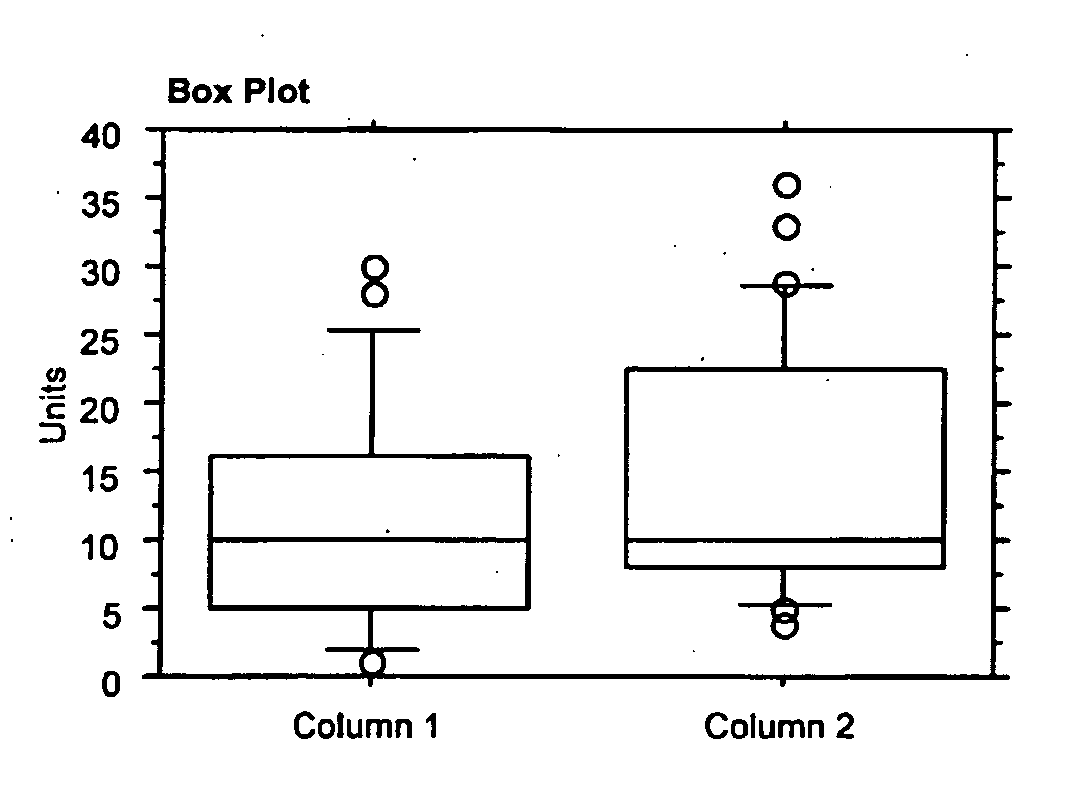Use of Fibroblast Growth Factor Fragments
- Summary
- Abstract
- Description
- Claims
- Application Information
AI Technical Summary
Benefits of technology
Problems solved by technology
Method used
Image
Examples
example i
Integrated Investigative Pharmacology Through In Vivo Gene Expression Profiling in Mice
[0131]In this EXAMPLE, 100 unknown chemically synthesized peptides are functionalized using the discovery method of the invention. Most of these peptides are present in human plasma.
[0132]As a control, twenty reference drugs are concurrently investigated with the discovery method of the invention. For this screening, one control and four treated groups of six males are treated for two weeks by daily administration by the subcutaneous route of the proteins. The reference drugs can be active for treating conditions in the areas of glaucoma, neuroprotection, neovascularisation, antiangiogenesis, acne, asthma and allergy, cardiovascular diseases, neurological disorder, pain, diabetes, hypercholesterolemia, osteoporosis and oncology.
[0133]The expectations from those selected active peptides are that (a) several potential therapeutic drugs could be identified; (b) target peptides for therapeutic antibod...
example ii
A 7-Day Pharmacology and Toxicity Study by Subcutaneous Route in Mice; Microarray Gene Expression Analysis
[0135]Introduction and summary. Five peptides with unidentified function were tested in mice to obtain biochemical and pharmacogenomic data that would allow a specification of their activity. Outbred CD-1 mice were treated with peptides GPA018, GPA019, GPA020, GPA022, and GPA023 for seven days, observed for clinical signs of treatment effects (mortality, clinical signs, body weight, food consumption, haematology, clinical biochemistry) and, after sacrifice, a selected set of tissues were used for gene expression profiling. A snap freezing sampling of the tissues was performed at necropsy at the end of the treatment period. These tissues were used for mRNA expression profiling and for histopathological analysis (formalin fixation). In addition, parameters investigated in a standard exploratory study were recorded. None of the peptides had any influence on clinical or pharmacogeno...
example iii
Multi-Organ Gene Expression Profiling of Cynomolgus Monkey Treated with FGF23CTP (100 μg / day sc)
[0158]Introduction and summary. The aim of this EXAMPLE was to identify for the peptide FGF23CTP modes of action with possible therapeutic applications by multi-organ microarray profiling in monkey. The peptide FGF23CTP (GPA006, GeneProt, Geneva, Switzerland) is derived from a unique COOH-terminal domain of the FGF-23. It is a unique 75-mer COOH-terminal peptide of FGF-23 with no homology to regions of other FGF family members. See, PCT patent application WO 02 / 088,358, the contents of which are incorporated by reference. In the brain FGF-23 transcripts are preferentially expressed in the thalamus (Yamashita T et al., Biochem. Biophys. Res. Commu., 277: 494-8 (2000)). Mutations in this region of the FGF-23 molecule were proposed as causative events in a renal phosphate wasting syndrome responsible for a form of autosomal dominant rickets (Saito H et al., Am. J. Pathol. 156: 697-707 (2002)...
PUM
| Property | Measurement | Unit |
|---|---|---|
| Fraction | aaaaa | aaaaa |
| Gene expression profile | aaaaa | aaaaa |
| Threshold limit | aaaaa | aaaaa |
Abstract
Description
Claims
Application Information
 Login to View More
Login to View More - R&D
- Intellectual Property
- Life Sciences
- Materials
- Tech Scout
- Unparalleled Data Quality
- Higher Quality Content
- 60% Fewer Hallucinations
Browse by: Latest US Patents, China's latest patents, Technical Efficacy Thesaurus, Application Domain, Technology Topic, Popular Technical Reports.
© 2025 PatSnap. All rights reserved.Legal|Privacy policy|Modern Slavery Act Transparency Statement|Sitemap|About US| Contact US: help@patsnap.com



